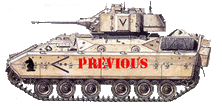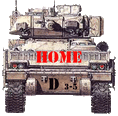The Mission
Delta Company, 3-5 Cavalry, was task organized with an M1 Abrams Tank Battalion, 4-34 Armor from the 8th Infantry Division from Mainz, Germany. This Battalion replaced one of the Ready First Combat Teams, that did not deploy. 4-34 AR, "Task Force Centurions" was the only combat unit to deploy from the 8th ID. It was commanded by LTC Burton, who's nick name was "Soldier Hard". He was a little like General George Patton, and a little like the Cav Commander on Apocalypse Now - the "I love the smell of napalm" guy. Delta Company was further task organized within the task force as a mech company team - Two platoons of mech Infantry, and one platoon of M1 tanks.
Given the mission to destroy elements of the Iraqi Republican Guard, TF Centurions was to cross the Kuwaiti border into Iraq and move as part of General Schwarzkopf's "Hail Mary" to Objective Collins, a large piece of desert North West of Kuwait City. The TF expected to encounter enemy armor and Infantry dug-in in elaborate defensive belts. Tank crews learned to respect Infantry soldiers armed with anti tank missiles after the Arab/Israeli wars of the 60's. So, as Task Force Centurion was to approach these defensive positions, the tanks were to halt, and provide near and far security for the Bradley's approach up to the trenches. As the tanks and Bradley's engaged the enemy, the ramps would be lowered and the Infantry squads would dismount. Once online at the ramp, either with one team on each side of the vehicle or the entire squad on one side or the other (terrain dependent) the squad was to quickly use individual movement techniques to come on-line with the front road wheel of the vehicle. The squad leader would then cook off a grenade and throw it into the trench at the entrance location. At that point, while being covered by the Bradley's 25mm automatic cannon and coaxial machine gun, the entire squad would rush the trench, entering just after the explosion. Then the squad would assault forward down the length of the trench. The key to a successful assault is speed and violence. After clearing the trench, the soldiers were to mount up, and the TF would move forward to the next dug in position.
The "Fighting First" was selected by Captain Brown, our Company Commander, to be the lead squad in the Company trench assault. There are a total of 6 squads in a Company, organized into 3 platoons.
After many rehearsals conducted in accurately reproduced trenches, (provided by aerial reconnaissance) the technique and procedure developed was to lead with the 3 SAW gunners. PFC Zappone was the lead machine gunner, placing maximum fire power to the front, followed by the other 2 SAW gunners, who were to fire down branches. CPL Williams was to throw a grenade around each corner encountered prior to rounding the corner. I was to be located between the two fire teams. Behind me was the trail team, who would carry more ammo, evac casualties and replace any wounded SAW gunners. Our Platoon Sergeant, SFC Davis, was to have his BFV straddling the trench, firing his Coax Machine gun over our heads to suppress the enemy as we moved down the trench. 1LT Walter, our Platoon Leader would dismount (early doctrine provided that the PL be on the ground to lead the platoon and the platoon sergeant control the 4 Bradley's) coordinating between the two 9 man squads and the 4 BFV's. The Second Squad would enter the trench, to provide overwhelming firepower to eliminate enemy resistance. Florescent VS-17 panels were secured on our backs and my radio antenna to prevent fratricide. The Bradley's were to provide near and far security with their 25mm automatic cannons, 7.62mm coaxial machine guns and TOW missile launchers. This was ensure we would not receive any unwanted enemy pressure during the assault. A reassuring measure was that the Combat Ambulance, a M113 Armored Personnel Carrier with red crosses painted on all 4 sides, was to drive right up to the toe-hold, to quickly evac any casualties. A combat medic accompanied us into the trench with his giant aid bag, loaded with IV's, hemorrhage control equipment, airway management systems, splints and morphine. Each soldier was designated as a primary or alternate aid and litter team member.
This mission was constantly rehearsed, day, night, and with our chemical gear on. I realized during one rehearsal, when I gave the command to "fix bayonets", that only 3 of the 9 soldiers had weapons that were capable - the 203's and SAW's were not capable of attaching bayonets. (Although CPL Williams quickly detached his 203 tube and fixed his bayonet). Although there was no expectation of a bayonet assault, they where to discourage the enemy from batting our muzzle away while in close quarters. Of all things to find in the desert, I came across a dental mirror, which I stuck in my helmet and used as a "rear view mirror", to monitor the situation to my rear. Situational awareness was paramount for everyone involved.
We had the plan worked out as well as it could be. The squad was confident but knew what could happen. At this point we still did not know what type of enemy resistance to expect, but expected a prolonged fight. We sat in the open desert on high alert for over a month, ready to go at a moments notice. Honed to a razor's edge, tension mounting day after day. I didn't let my thoughts known to my men, but I really did not expect everyone to make it. Scud missiles came out of the north, flying over us headed toward Riyadh. Some were engaged by Patriot Missiles, some were not. It was becoming very "real" to everyone. Rosado and Zappone were married, Zap had a young daughter. We made a pact that if anyone were killed, another squad member would contact the family. I eventually received the operations order, and issued it to the squad. We were locked and loaded. When our battalion chaplain, Captain (RANGER) Moran, came to our position the night before the Ground War started, everyone got a Bible or a Rosary, and prayed.
Delta Company, 3-5 Cavalry, was task organized with an M1 Abrams Tank Battalion, 4-34 Armor from the 8th Infantry Division from Mainz, Germany. This Battalion replaced one of the Ready First Combat Teams, that did not deploy. 4-34 AR, "Task Force Centurions" was the only combat unit to deploy from the 8th ID. It was commanded by LTC Burton, who's nick name was "Soldier Hard". He was a little like General George Patton, and a little like the Cav Commander on Apocalypse Now - the "I love the smell of napalm" guy. Delta Company was further task organized within the task force as a mech company team - Two platoons of mech Infantry, and one platoon of M1 tanks.
Given the mission to destroy elements of the Iraqi Republican Guard, TF Centurions was to cross the Kuwaiti border into Iraq and move as part of General Schwarzkopf's "Hail Mary" to Objective Collins, a large piece of desert North West of Kuwait City. The TF expected to encounter enemy armor and Infantry dug-in in elaborate defensive belts. Tank crews learned to respect Infantry soldiers armed with anti tank missiles after the Arab/Israeli wars of the 60's. So, as Task Force Centurion was to approach these defensive positions, the tanks were to halt, and provide near and far security for the Bradley's approach up to the trenches. As the tanks and Bradley's engaged the enemy, the ramps would be lowered and the Infantry squads would dismount. Once online at the ramp, either with one team on each side of the vehicle or the entire squad on one side or the other (terrain dependent) the squad was to quickly use individual movement techniques to come on-line with the front road wheel of the vehicle. The squad leader would then cook off a grenade and throw it into the trench at the entrance location. At that point, while being covered by the Bradley's 25mm automatic cannon and coaxial machine gun, the entire squad would rush the trench, entering just after the explosion. Then the squad would assault forward down the length of the trench. The key to a successful assault is speed and violence. After clearing the trench, the soldiers were to mount up, and the TF would move forward to the next dug in position.
The "Fighting First" was selected by Captain Brown, our Company Commander, to be the lead squad in the Company trench assault. There are a total of 6 squads in a Company, organized into 3 platoons.
After many rehearsals conducted in accurately reproduced trenches, (provided by aerial reconnaissance) the technique and procedure developed was to lead with the 3 SAW gunners. PFC Zappone was the lead machine gunner, placing maximum fire power to the front, followed by the other 2 SAW gunners, who were to fire down branches. CPL Williams was to throw a grenade around each corner encountered prior to rounding the corner. I was to be located between the two fire teams. Behind me was the trail team, who would carry more ammo, evac casualties and replace any wounded SAW gunners. Our Platoon Sergeant, SFC Davis, was to have his BFV straddling the trench, firing his Coax Machine gun over our heads to suppress the enemy as we moved down the trench. 1LT Walter, our Platoon Leader would dismount (early doctrine provided that the PL be on the ground to lead the platoon and the platoon sergeant control the 4 Bradley's) coordinating between the two 9 man squads and the 4 BFV's. The Second Squad would enter the trench, to provide overwhelming firepower to eliminate enemy resistance. Florescent VS-17 panels were secured on our backs and my radio antenna to prevent fratricide. The Bradley's were to provide near and far security with their 25mm automatic cannons, 7.62mm coaxial machine guns and TOW missile launchers. This was ensure we would not receive any unwanted enemy pressure during the assault. A reassuring measure was that the Combat Ambulance, a M113 Armored Personnel Carrier with red crosses painted on all 4 sides, was to drive right up to the toe-hold, to quickly evac any casualties. A combat medic accompanied us into the trench with his giant aid bag, loaded with IV's, hemorrhage control equipment, airway management systems, splints and morphine. Each soldier was designated as a primary or alternate aid and litter team member.
This mission was constantly rehearsed, day, night, and with our chemical gear on. I realized during one rehearsal, when I gave the command to "fix bayonets", that only 3 of the 9 soldiers had weapons that were capable - the 203's and SAW's were not capable of attaching bayonets. (Although CPL Williams quickly detached his 203 tube and fixed his bayonet). Although there was no expectation of a bayonet assault, they where to discourage the enemy from batting our muzzle away while in close quarters. Of all things to find in the desert, I came across a dental mirror, which I stuck in my helmet and used as a "rear view mirror", to monitor the situation to my rear. Situational awareness was paramount for everyone involved.
We had the plan worked out as well as it could be. The squad was confident but knew what could happen. At this point we still did not know what type of enemy resistance to expect, but expected a prolonged fight. We sat in the open desert on high alert for over a month, ready to go at a moments notice. Honed to a razor's edge, tension mounting day after day. I didn't let my thoughts known to my men, but I really did not expect everyone to make it. Scud missiles came out of the north, flying over us headed toward Riyadh. Some were engaged by Patriot Missiles, some were not. It was becoming very "real" to everyone. Rosado and Zappone were married, Zap had a young daughter. We made a pact that if anyone were killed, another squad member would contact the family. I eventually received the operations order, and issued it to the squad. We were locked and loaded. When our battalion chaplain, Captain (RANGER) Moran, came to our position the night before the Ground War started, everyone got a Bible or a Rosary, and prayed.


